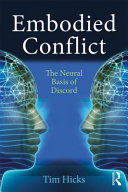Embodied Conflict The Neural Basis of Conflict and Communication 1st Edition by Tim Hicks ISBN 9781351616737 1351616730
$50.00 Original price was: $50.00.$25.00Current price is: $25.00.
Embodied Conflict : The Neural Basis of Conflict and Communication 1st Edition by Tim Hicks – Ebook PDF Instant Download/Delivery: 9781351616737, 1351616730
Instant download Full Chapter of Embodied Conflict : The Neural Basis of Conflict and Communication 1st Edition after payment

Product details:
ISBN 10: 1351616730
ISBN 13: 9781351616737
Author: Tim Hicks
Our abilities to learn and remember are at the core of consciousness, cognition, and identity, and are based on the fundamental brain capacity to encode and store perceptual experience in abiding neural structures. These neural structures are the mechanisms by which we know, think about, create beliefs about, and understand the world in which we live. This includes the social world in which we experience conflict with others; our conflicts are largely about differences in what we know, think, believe, and understand. A number of characteristics of the neural encoding function are at the root of and help to explain conflict in our social relations and why some conflicts are difficult to prevent and resolve.
Embodied Conflict presents the neural encoding function in layman’s terms, outlining seven key characteristics and exploring their implications for communication, relationship, and conflict resolution. In doing so, Embodied Conflict situates the field of conflict resolution within the long arc of human history and asks whether and how conflict resolution practice can take another step forward by considering the neural experience of parties in conflict. The book includes many case examples and offers some suggestions for how conflict resolution practitioner training might be expanded to include this theoretical framework and its implications for practice.
Table of contents:
Introduction
1 Some Basics About Humans as Living Organisms
At Birth No Knowing
We Navigate to Survive
Only Our Five Senses
Three Levels of Survival
Constant Process of Environmental Assessment
2 The Neural Encoding Function
Prenatal Beginnings
Birth and the Beginning of Meaning Making
3 Some Key Characteristics of the Neural Encoding System
Connectivity, Coherence, and Consistency
Neural Stability and Plasticity
Neural Activation
Delay between Stimulus and Response
Expectancy
The Dorsal and Ventral Systems and their Balance
Memory
4 Implications for Conflict and its Resolution
Communication
Perception
Identity
Relationship
Trust, Betrayal, and Trauma
Priming, Mirroring, and Affect Contagion
Knowing and Certainty, Learning and Change
5 What Can We Do with This Information? Applications to Practice
Theoretical Issues
Stages of a Process
Practice Issues
Process Design Considerations
6 Implications for Training
7 Conclusion
Appendix: Digest of Specific Practice Approaches Discussed or Suggested in the Text
People also search:
embodied neuroscience
embodied conflict
embodied consciousness
an embodied life
embodied neurobiology
You may also like…
Politics & Philosophy - Others
Linguistics - Sociolinguistics
Business & Economics - Management & Leadership
Conflict Coaching Fundamentals Working With Conflict Stories 1st Edition Hardy
Uncategorized
The Walls Between Conflict and Peace 1st Edition by Alberto Gasparini ISBN 9004272844 9789004272842
History - Middle Eastern History
Military Aspects of the Israeli Arab Conflict 1st Edition by Louis Williams 9781351319027 1351319027
Politics & Philosophy - Others
Politics & Philosophy - Warfare & Defence
The Palgrave Encyclopedia Of Peace And Conflict Studies 1st Edition Oliver P. Richmond
History - Middle Eastern History
Uncategorized










